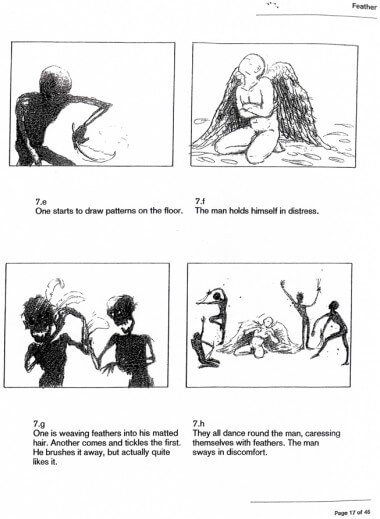Barry Purves Interview – Respect the Puppets! Part One
Barry JC Purves is a well known figure in the world of stop motion animation. If you do not recognize his name then you are bound to have heard of some of the productions he has worked on as an animator and director in the past. From children’s classics such as Wind in the Willows, Postman Pat and Rupert Bear – Follow the Magic, right the way through to his involvement with features such as Peter Jackson’s “King Kong” and Tim Burtons “Mars Attacks”. But if you wish to gain a better understanding of Purves as an individual artist you have to take a look at his own films such as ‘Next!’, ‘Gilbert and Sullivan’, ‘Achilles’, ‘Rigoletto’ and ‘Screen Play’. Fans of his work will be pleased to know that within the past year Barry has created two more films to add to his profile.
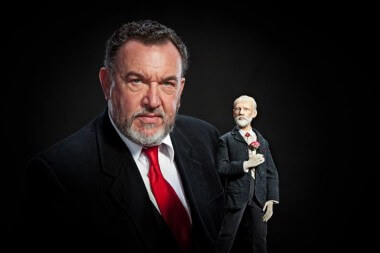
Barry Purves with his puppet of Tchaikovsky by Mackinnon and Saunders. Portrait by Keiron Nevison
Purves’ animation style could be easily compared to the work of Ray Harryhausen, the famous monster special effects legend, as most stop motion animators invariably do when Wallace and Gromit do not spring to mind. But it is Purves’ background and involvement in theatre that distinguishes him from Harryhausen. Whilst Harryhausen’s work puts you in mind of myth and fantasy, Purves’ work, although capable of that, takes a greater emphasis on the acting and the theatrical that distinguishes him from other stop motion animators.
Purves’ most recent films do not deviate from his formula but remain distinct from each other as well. ‘Plume’ takes place in a sparse fantasy world whereas ‘Tchaikovsky’ is a portrait of the famous musician, cramming his entire complex lifetime into just 13 minutes.
‘Plume’ may be one of Purves’ simplest animation productions as we watch the tale of a winged man swooping around a pitch-black background. The simplicity of the setting only adds emphasis to the wonderful animation achieved, especially on the characters wings, as he soars across the screen and you get a real feel for the weight and movement of the figure. The character is accompanied on screen by three vicious monsters that seek to devour the wings that help him soar through the blackness. Due to the minimalist background of this film you are engaged with the characters with every second they are on screen and feel for every tragedy, horror and triumph they encounter.
We managed to catch up with Barry Purves and ask him a few questions about these two works and his past. Return to Skwigly to read part two of the interview where Barry discusses Tchaikovsky in greater depth
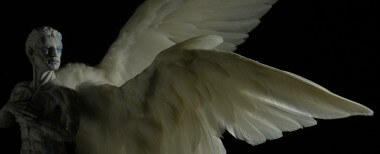
Pre-production Photograph from Plume
Plume was 16 years in the making, how does it differ in its final incarnation compared to its original inception where did the idea originate?
When you write a project your imagination just flows! You usually have some idea about budget and schedule but still try to write freely and honestly. Then when you get the budget and you do have to compromise, but this is part of the process. Getting the money was a problem for this film, it went through lots of different forms, at one stage it was going to be live action, and it almost became a dance piece in New Zealand, but neither happened. All sorts of people turned it down but happily the producers in France – Dark Prince – saw a retrospective of my work and managed to raise, for this climate, a surprisingly healthy budget. There were originally four shadowy characters but we lost one due to economics, which is okay because I think three characters made for practical choreography. It was a tough schedule of around 11-12 seconds per day, which is again down to economics, but I have spent years working at that pace. Have a look at the original storyboard of the film in my first book, and see how the film has developed.
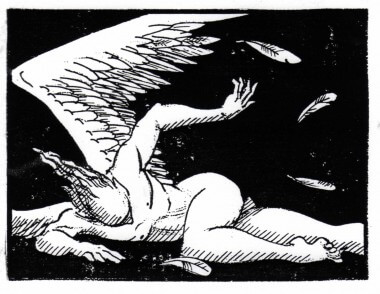
Early Storyboard panel From Plume
I was away from home for four months, shooting in a tiny town called Chateau Renault and the complex logistics of getting me back to London prevented me from speaking at Ray Harryhausen’s 90th birthday celebrations, alongside the likes of John Landis and Peter Jackson. I was sad not to have been able to pay tribute to Ray so publicly, but I recently caught up with Ray over breakfast for a proper chat.
So you are good friends with Ray Harryhausen then?
Yes, we have done a good few talks and panels together and I interviewed him on stage at BAF. He enjoyed that because many people who interview him are academics or film theorist, and there we were, two animators, chatting about character acting and motivation.
What does he think to the films?
He loves them, I believe.
Where did the original idea of Plume come from?
Two events happened at the same time really. ‘Mars Attacks!’ was going to see the Martians as stop motion characters. They were eventually CG creations, which made me run around like a headless chicken saying ‘IT’S THE END! IT’S THE END!’ I knew I was going to have to adapt, so the idea of adapting became one theme. My beloved mother died at the same time and I thought to myself ‘how do I get through this traumatic event with some hope?’ Surviving such a trauma thus became a second theme. The need to make this very personal film was so strong, but to do a more literal film would have been economically prohibitive. I started to think that I didn’t need sets; I didn’t need costumes; I just needed puppets. So I started to find a traumatic, almost abstract life changing event for the character. The loss of wings seemed a good metaphor, and a photo of me swimming underwater, but looking as if I could have been flying, convinced me of the narrative. With the focus on movement, the idea of a film that was half ballet and half rugby scrum appealed to me. The film is full of symmetry and contrasts, especially with light and shade, and I guess, good and evil, innocence and experience. The shadowy characters are what the main character would become if he were to succumb to grief or give up. That was the root of the film.
Wings seem to feature heavily in your two new films and in a fair few of your other works. Both ‘Plume’ and ‘Tchaikovsky’ feature them is there significance to them for you?
I do have this obsession with wings, certainly, and in every film I have done a character transforms into something with wings or into a bird. I like the idea of transformation as metaphor; I don’t know what they represent to me; maybe some kind of freedom from social, cultural, gender, gravity. Or perhaps some kind of expression of true unfettered self? The wings in ‘Plume’ are a kind of joy for art and beauty that gets raped and destroyed. All drama is about a change of perspective. The protagonist gets a glimpse of his real self through a change of perspective. With Tchaikovsky, so much of the music of his operas and ballets is about change, liberation and escape from restrictive convention and conduct. This is particularly true in ‘Swan Lake’ where the swans represent an alternative to the court. With Tchaikovsky being a gay man, seeking escape from the restrictions of Moscow society, it is not hard to see the parallels.
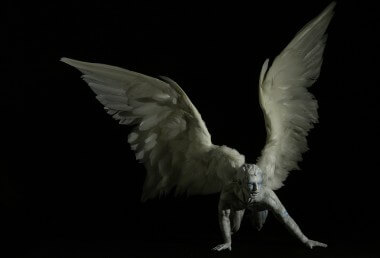
Pre-production photograph from Plume
Even in things like ‘The Wind in the Willows’ I was getting role playing of characters becoming other animals and birds, and in ‘Next’ there are the wings at the climatic scene from ‘Cymbeline’. In ‘Screen Play’ the lovers literally become birds at the end and all the way through there are two birds echoing the narrative and foreshadowing the end. In ‘Rigoletto’ the cast are all wearing bird masks which are a quick, visual shorthand clue to understanding the social hierarchy. The Duke is wearing an eagle’s head, whilst Rigoletto wears a turkey head! In ‘Gilbert and Sullivan’ they become fairies, and in ‘Hamilton Mattress’ an Aardvark goes to beak city! The birds are more corrupt there but it’s the same story of going to a different place to learn about yourself. Even in ‘Rupert Bear’ I developed the storyline where characters were transformed into birds to rescue an abandoned nest. Wings, well for me, they probably represent a true self and potential.
Plume is very open to interpretation and although you can compare the main character to an Angel or Aros or Anteros, the winged god of Greek mythology but you have said they are not. What was the thought behind the character and is flying used as a metaphor that the rest of the story then follows?
It was important to me that there were no cultural references in this film. He is simply a man with wings who gets raped of what defines him and that’s it. I certainly did not want to make him an angel (though many have read religious falls and redemptions into the film) and I didn’t want to make him Icarus so I stripped him of any costume and identity, so that he could become Everyman. He is naked, but not because I wanted to show off his body but because he is a raw man with wings. I wanted to be as metaphorical as I could. We gave him some blue woad body paint, mainly so that there would be some cathartic washing away in the final scene.
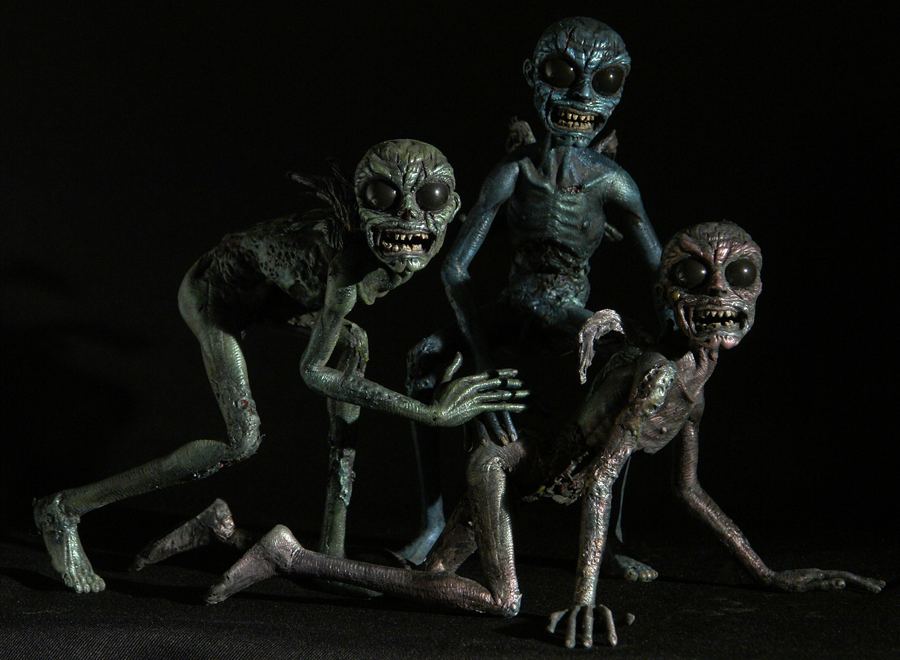
The villainous “Shadows”
The character was nameless, deliberately, but by the end of the shoot he had become ‘Cliff’, simply because we referred to the others as The Shadows – a feeble pun that confused our French crew. The puppet, well Cliff, is in Paris at the moment, I have not seen him in over a year. I miss him, actually, but I am happy that his original wings have been restored to him.
Part Two of “Barry Purves – Respect the Puppets!” can be found here.
Barry Discussing the making of Plume at the Bradford Animation Festival



